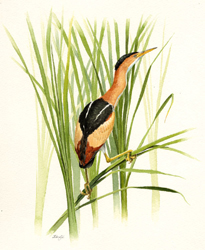Find a Bird - BBA1
Breeding Bird Atlas 1 Species Accounts
Least Bittern
Ixobrychus exilis
State Status
Endangered
Egg Dates
June 1 to June 30
Number of Broods
one; may re-lay if first attempt fails.

The Least Bittern has always been considered a rare and local summer resident in Massachusetts. In earlier years, this status may have had more to do with its secretive and retiring habits than its actual numbers. However, today there is no question that the Least Bittern is scarce, the consequence of the draining and filling of wetlands. Wetland alteration and ecological changes have produced a marked reduction in the extensive areas of cattails in freshwater marshes or broad river meadows that are essential to the species’ existence. The birds are distributed sparsely in the eastern portions of the state and are rarely encountered in central and western Massachusetts.
Resident Least Bitterns usually arrive by the middle of May. Migrants are seldom noted, but there are several reports of unseasonal occurrences in coastal areas in late March and April following southerly coastal storms. They are, for the most part, nocturnal migrants. Unlike their larger relative, the American Bittern, Least Bitterns do not engage in an elaborate courtship display. The voice is a series of rapidly repeated coos and is very much reminiscent of one of the calls of the Black-billed Cuckoo. Least Bitterns are most vocal at dawn, but they sometimes also call in the middle of the day.
Nesting normally commences in late May. In a dense stand of cattails, several stalks are bent over to form a loose platform on which the nest is constructed. Additional stalks, grasses, and reeds are then used to complete the nest. There is an early record of a female building a nest on May 19. The usual clutch is four or five bluish or greenish eggs, and incubation is shared by both sexes for about two and a half weeks. When the eggs hatch and the parents begin to feed the young, the bitterns become more visible; for, once an adult has obtained the necessary food, it makes a direct flight just over the top of the marsh vegetation and drops abruptly in the proximity of the nest. Late June or early July is the time when this activity is most likely to be observed.
Later, when the young have fledged and the adults are molting, they sometimes can be observed feeding or resting as a family group. Most sightings of such groups in Massachusetts occur at Plum Island. The favored feeding areas are usually open areas in the marsh, where the birds forage from the edge or by wading in shallow water.
The fall migration is not very apparent, and little is known about it. Presumably, most individuals move through or depart our area in late August and September, at which time the species is rarely encountered, and then usually in coastal salt marshes. There are a few reports from October to December.
In the rare dark color morph known as “Cory’s” Least Bittern, the buff coloration on the body and wings is replaced by a dark chestnut color. This form has occurred twice in Massachusetts, most recently in 1945.
The Least Bittern is listed as an endangered species in Massachusetts.
Map Legend and Data Summary
Atlas 1 data collected from 1975-1979


Note: rare and local in freshwater marshes with extensive cattails
Richard A. Forster



